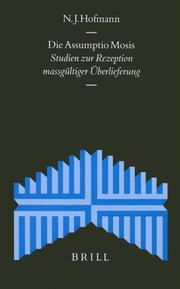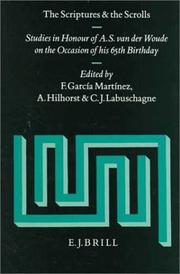| Listing 1 - 10 of 41 | << page >> |
Sort by
|
Book
ISBN: 1139169130 110804347X Year: 2015 Publisher: Cambridge : Cambridge University Press,
Abstract | Keywords | Export | Availability | Bookmark
 Loading...
Loading...Choose an application
- Reference Manager
- EndNote
- RefWorks (Direct export to RefWorks)
The biblical scholar Margaret Gibson (1843-1920) was credited with the discovery of a number of significant ancient manuscripts. This volume, the transcription of an Arabic manuscript from the monastic library of St Catherine on Mount Sinai, first published in 1901,includes the stories of Aphikia and Cyprian and Justa.
Apocryphal books --- Translations into English. --- Apocryphal literature --- Pseudepigrapha --- Sacred books

ISBN: 9789004497436 9789004119383 Year: 2000 Publisher: Leiden;Boston BRILL
Abstract | Keywords | Export | Availability | Bookmark
 Loading...
Loading...Choose an application
- Reference Manager
- EndNote
- RefWorks (Direct export to RefWorks)
This study places the Assumptio Mosis ( AM ) in its literary context of traditions of the 2nd century BC to the 1st century AD. It examines how in AM the biblical traditions have been adopted and adjusted (Deut 31 - Josh 1) to the actual circumstances. After presenting the current state of affairs in research and analysing the structure of the AM , the investigation focuses on a detailed account on how Deut 31 - Josh 1 has been incorporated in the AM and how this process affected the theological content. Furthermore the AM is put in a comparative perspective with other apocryphal traditions of the 2nd century BC to the 1st century AD (1-Enoch, T.12 Patr., Jub., 1-2-4 Macc, Ps Sal, Qumran texts, 4 Ezra, 2 Bar, Liber Antiquitatum Biblicarum) to try and characterise the place of the AM within this contemporary literature. This process of reception is clarified against the background of the so-called Rewritten-Bible-phenomena. A pattern can be discerned within this process, whereby actualising and adjusting to the historical circumstances are major objectives.
Book
ISBN: 3535013879 9783535013875 Year: 1972 Publisher: Osnabrück: Zeller,
Abstract | Keywords | Export | Availability | Bookmark
 Loading...
Loading...Choose an application
- Reference Manager
- EndNote
- RefWorks (Direct export to RefWorks)
Apocryphal books --- 276 =932 --- Apocryphal literature --- Pseudepigrapha --- Sacred books --- Koptische patrologie. Koptische christelijke literatuur
Periodical
Abstract | Keywords | Export | Availability | Bookmark
 Loading...
Loading...Choose an application
- Reference Manager
- EndNote
- RefWorks (Direct export to RefWorks)
Apocryphal books --- Apocryphes (Ancien Testament) --- Critique, interprétation, etc. --- Apocryphal books. --- Apocryphal literature --- Pseudepigrapha --- Sacred books --- Jewish Life & Spirituality. --- Jewish Literature.
Book
ISBN: 9781426742354 1426742355 Year: 2012 Publisher: Nashville: Abingdon press,
Abstract | Keywords | Export | Availability | Bookmark
 Loading...
Loading...Choose an application
- Reference Manager
- EndNote
- RefWorks (Direct export to RefWorks)
Book
ISBN: 9783161602337 3161602331 9783161602344 Year: 2021 Volume: 470 Publisher: Tübingen: Mohr Siebeck,
Abstract | Keywords | Export | Availability | Bookmark
 Loading...
Loading...Choose an application
- Reference Manager
- EndNote
- RefWorks (Direct export to RefWorks)
Glaubt man den Angaben des Kolosserbrifes, dann wurde das Schreiben von Paulus in einer Haftsituation fertigestellt, spätestens kurz vor dem Tod des Apostels. Aber wann entstand der Text, wenn er gar nicht von Paulus verfasst wurde? Die im neutestamentlichen Kanon enthaltenen pseudepigraphischen Briefe entziehen sich einer zweifelsfreien Datierung, indem sie falsche Angaben zu einer angeblich früheren Abfassung machen und so die zeitlichen Umstände der tatsächlichen Niederschrift verbergen. Dieser Band bündelt nich nur die Debatten zur Datierung der einzelnen neutestamentlichen Pseudepigraphen, die Autorinnen und Autoren der in ihm versammelten Beiträge sichten auch kritisch methodische Zugänge zur zeitlichen Einordnung der Texte und beleben die Diskussion, indem sie mit neuen Ansätzen versuchen, hinter die pseudepigraphischen Fassaden der Briefe zu blicken.
Apocryphal books --- 229*4 --- 229*4 Apocriefen van het Nieuwe Testament--(algemeen) --- Apocriefen van het Nieuwe Testament--(algemeen) --- Apocryphal literature --- Pseudepigrapha --- Sacred books --- Dating
Book
ISBN: 3161559444 9783161559440 3161556518 9783161556517 Year: 2018 Publisher: Tübingen Mohr Siebeck
Abstract | Keywords | Export | Availability | Bookmark
 Loading...
Loading...Choose an application
- Reference Manager
- EndNote
- RefWorks (Direct export to RefWorks)
In dieser Studie untersucht Olivia Stewart Lester wahre und falsche Prophezeiungen im Geflecht von Deutung, Geschlecht und Wirtschaft in der Offenbarung des Johannes, den Sibyllinischen Orakeln 4–5 und zeitgenössischen antiken Texten aus dem Mittelmeerraum.
Prophecy. --- Bible. --- Oracula Sibyllina --- Criticism, interpretation, etc. --- New Testament --- Old Testament Pseudepigrapha --- Violence --- Greco-Roman World --- Delphi --- Antike Religionsgeschichte --- Antike --- Neues Testament --- Altes Testament
Book
Year: 2015 Publisher: Tübingen, Germany : Mohr Siebeck,
Abstract | Keywords | Export | Availability | Bookmark
 Loading...
Loading...Choose an application
- Reference Manager
- EndNote
- RefWorks (Direct export to RefWorks)
This volume collects the contributions of a group of North American scholars who started rethinking, in 2004, the traditional category of New Testament Apocrypha, largely dominated by theological concerns, according to the new perspectives of a greater continuity not only between Second Temple Jewish and early Christian scriptural productions, but also between early Christian and late antique apocryphal literatures. This is the result of the confluence of two, so far, alternative approaches: on the one hand, the deconstruction of the customary categories, inherited from ancient heresiology, of "Jewish Christianity" and "Gnosticism," and on the other hand, the new awareness that the production of new apocryphal texts did not cease at the end of the third century but continued well into late antiquity and beyond. These papers bring together for the first time the typically North American need to reconsider "The Ways That Never Parted" and other artificially drawn "Border Lines" with the more European attention paid to the phenomenon of apocryphicity in the long term. In the twenty essays published here, different facets of this apocryphal continent are newly explored, from the Christian appropriation of Jewish stories and literary genres, with a special emphasis on the case of the late antique Pseudo-Clementines and their hypothetical Jewish Christian source, to the complex and controversial situation of the narrative roles attributed to such figures as Judas Iscariot, Mary of Magdala, Mary the mother of Jesus, or Peter. These new insights are particularly relevant not only for the history of the first Jesus movement but also, and especially, for gaining a better understanding of the ways Judaism and Christianity evolved initially together, then side by side, according to a process of differentiation that took more time than previously thought.
Apocryphal books (New Testament) --- Apocryphal books (Old Testament) --- Criticism, interpretation, etc. --- Jewish Christianity --- Pseudepigrapha --- Gnosticism --- Pseudo-Clementine Literature --- Neues Testament --- Antike Religionsgeschichte --- Antike --- Kirchengeschichte
Book
ISBN: 9783110212488 9783110212495 3110212498 311021248X 9786612716287 6612716282 128271628X 9781282716285 Year: 2010 Publisher: Berlin New York
Abstract | Keywords | Export | Availability | Bookmark
 Loading...
Loading...Choose an application
- Reference Manager
- EndNote
- RefWorks (Direct export to RefWorks)
This work provides the key to one of the most enigmatic Jewish Hellenistic texts preserved in Greek and Slavonic. Despite the fact that 3 Baruch is one of the major early Jewish apocalypses, it has been relatively neglected in modern scholarship, probably since 3 Baruch is one of the most difficult works to comprehend and classify. Its content differs significantly from that of other writings of the same genre, as the book preserves syncretistic ideas and tendencies which are combined in unique ways. The worldview, the message, and the very textual structure of 3 Baruch are enigmatic in many respects. The present study demonstrates that the textual history of 3 Baruch, implicit meanings and structural links in its text, as well as conceptions behind the text, are partly reconstructable. Moreover, 3 Baruch, properly read, significantly enriches our understanding of the history of the motifs found in early Jewish lore, at times providing missing links between different stages of their development, and preserves important evidence on the roots of Jewish mysticism, proto-Gnostic and proto-Christian traditions. The study contains the introduction, synoptic translation, textual notes, and detailed commentaries.
Greek Apocalypse of Baruch --- Criticism, interpretation, etc. --- 229*234 --- 229*234 Apocalypse van Baruch --- Apocalypse van Baruch --- Apocalypse of Baruch (Greek) --- 3 Baruch (Apocryphal book) --- Third Baruch (Apocryphal book) --- Apocalypsis Baruchi Graece --- Greek Baruch (Apocryphal book) --- Apocryphal books. --- Apocryphal literature --- Pseudepigrapha --- Sacred books --- Baruch (Apocalypse de) --- Apocalpse. --- Baruch. --- Pseudepigrapha.

ISSN: 00835889 ISBN: 9004097465 9004275738 9789004097469 9789004275737 Year: 1992 Volume: v. 49 Publisher: Leiden ;New York E.J. Brill
Abstract | Keywords | Export | Availability | Bookmark
 Loading...
Loading...Choose an application
- Reference Manager
- EndNote
- RefWorks (Direct export to RefWorks)
The present volume was compiled as a respectful tribute to A.S. van der Woude and presented to him on the occasion of his 65th birthday, which coincided with his retirement as professor of Old Testament and Intertestamental Studies at the University of Groningen, a chair he held for more than thirty years. The title of this Festschrift , The Scriptures and the Scrolls , reflects the two fields of study to which he has devoted his scholarly life, not only by doing research himself, but also by stimulating many of his colleagues to collaborate in publications initiated by him. The contributions, a mélange of studies covering the wide range of Van der Woude's interests, have been arranged according to the order: Hebrew Bible (following the sequence of the books), Apocrypha, Dead Sea Scrolls, and Rabbinic Tradition. From the Contents: E. Tov, '4QLevd (4Q26)' C.J. Labuschagne, ''You Shall not Boil a Kid in its Mother's Milk'. A New Proposal for the Origin of the Prohibition.' J.A. Emerton, 'The Translation of Isaiah 5,1.' J.T.A.G.M. van Ruiten, 'The Intertextual Relationship between Isa 11, 6-9 and Isa 65, 25.' W.A.M. Beuken, 'Isa 29, 15-24: Perversion Reverted.' W. McKane, 'Jeremiah 30, 1-3, Especially 'Israel.'' R.P. Carroll, 'Night without Vision. Micah and the Prophets.' C. van Leeuwen, 'The 'Northern One' in the Composition of Joel, 2, 19-27.' G. Wallis, A Note on Ps 45, 7aα.' M.J. Mulder, 'Does Canticles 6, 12 Make Sense?' B. Otzen, 'Michael and Gabriel. Angelological Problems in the Book of Daniel.' J.P.M. van der Ploeg, 'Some Remarks on a Newly Found Syriac Text of the Book of Judith.' A. Hilhorst, 'The Speech on Truth in 1 Esdras 4, 34-41.' P.R. Davies, 'Redaction and Sectarianism in the Qumran Scrolls.' M.A. Knibb, 'A Note on 4Q372 and 4Q390.' F. García Martínez, 'The Last Surviving Columns of 11QNJ.' G. Stemberger, 'The Maccabees in Rabbinic Tradition.' J. Neusner, 'How the Bavli Shaped Rabbinic Discourse: The Case of Sifra.' J.W. Rogerson, 'Writing the History of Israel in the 17th and 18th Centuries.' F. García Martínez, 'Bibliography of A.S. van der Woude.'
Apocryphal books --- Criticism, interpretation, etc. --- -#GROL:SEMI-221<08> Supp 49 --- Apocryphal literature --- Pseudepigrapha --- Sacred books --- Criticism, interpretation, etc --- #GROL:SEMI-221<08> Supp 49 --- History and criticism --- Bible --- Biblia --- Apocryphal books - Criticism, interpretation, etc.
| Listing 1 - 10 of 41 | << page >> |
Sort by
|

 Search
Search Feedback
Feedback About UniCat
About UniCat  Help
Help News
News